Cardano Price Analysis - Centralized testnet slated for move to decentralized mainnet later this year
Cardano (ADA) is a smart contract platform focused on peer-review and scientific study, marketed as a “third generation blockchain.” The coin is down 97% from the all-time high established in January 2018. The market cap is ranked 15th on the BraveNewCoin market cap table and currently stands at US$856 million, with US$30.8 million in trade volume over the past 24 hours.
ADA development began in 2015. A token presale raising US$62 million occurred in Asia, mainly Japan, from September 2015 to January 2017, where a total of 26 billion tokens were sold at US$0.0024 each. Public trading of the tokens began on October 1st, 2017. There is a hard cap of 45 billion ADA tokens, 13.88 billion of which will be issued through staking rewards.

The team initially included three conglomerates which held 5.18 billion ADA between them; the Cardano Foundation which aimed to standardize, protect, and promote ADA; Emurgo which aimed to develop, support, and incubate commercial ventures; and Input Output Hong Kong (IOHK), founded in 2015 by Charles Hoskinson and Jeremy Wood. IOHK also works on Ethereum Classic development and focuses on research and development in cryptography and distributed systems.
In October 2018, IOHK released a detailed blog post explaining several issues IOHK and Emurgo have had with the Cardano Foundation, including lack of strategic vision or plan, lack of transparency regarding operations, and misrepresentation of the Cardano trademark. Several members of the Cardano Foundation have since been replaced after restructuring in December 2018.
In March, the Cardano Foundation announced legal proceedings initiated by Z/Yen Group Limited. According to the post, “The proceedings relate to an alleged agreement between the Z/Yen Group Limited and the Cardano Foundation dated July 2017. The Cardano Foundation voided/terminated the agreement for various reasons. The Cardano Foundation fully rejects the claims raised by the Z/Yen Group Limited. Due to the ongoing nature of this judiciary process, no further information will be given while proceedings are in progress.”
In November 2018, Hoskinson announced IOHK would be leaving Hong Kong and incorporating in Wyoming. Then in February 2020, IOHK donated US$500,000 to the University of Wyoming and established a Cardano research lab, which will focus on writing code in ADA’s smart-contract language. The lab is also said to be designing a hardware tool for authentication and anti-counterfeit measures on Cardano. Hoskinson also mentioned future work with BeefChain, a livestock traceability platform, according to CoinDesk
In September 2019, Hoskinson announced a partnership with the New Balance shoe company to authenticate counterfeit goods. Despite teasing the news before an official announcement, an official press release from New Balance regarding the matter could not be obtained. Other reported partnerships include Polymath, StudEx, ScanTrust, Finkda Advisors, Dust Identity, PriceWaterhouseCoopers, the Priviledge Project, the government of Ethiopia, and the Berkman Klein Center of Harvard University
The ADA development roadmap includes five distinct phases; Byron, Shelley, Goguen, Basho, and Voltaire with three eras; testnet, bootstrap, and reward. Although currently in the bootstrap era, development occurs concurrently between all five phases.
The blockchain will eventually have two layers, the Cardano Settlement Layer (CSL) and Cardano Computation Layer (CCL). The blockchain will also support two scripting languages, Simon and Plutus, as well as sidechains. Currently, all ADA nodes are controlled by IOHK, Emurgo, and the Cardano Foundation, in a centralized manner.
Cardano 1.5.0 Mainnet was released in March 2019. Allowing for support of ADA’s consensus algorithm is Ourobouros, which uses Byzantine Fault Tolerant-Proof of Stake (BFT-PoS). PoS allows for social consensus and decentralized governance, as well as secure voting on peer-reviewed protocol proposals with a decentralized treasury to fund those proposals, similar to EOS (EOS), Tezos (XTZ), Dash (DASH), Decred (DCR), and PIVX (PIVX).
A Shelley testnet launched in June 2019 with a Shelley Incentivized Testnet (ITN) launch in December 2019. The ITN allows users to delegate ADA to various stake pools in the Daedalus or Yoroi wallet. According to adapools.org, there are currently 307 active pools with 12.56 billion ADA being staked, representing 40% of the circulating supply.
Time on the Cardano blockchain is divided into epochs and slots. A slot has a 20 second duration, while an epoch contains 21,600 slots, or five days in total. Stake pools will earn transaction fees and a share of the 13.88 billion ADA earmarked for staking rewards.
Subsequent protocol updates have also recently included a complete redesign of Byron, in preparation for the Shelley mainnet release. On February 12th, the CSL completed an architecture redesign of the Cardano Node and the Cardano Explorer Backend and Web API. Ourobouros was also updated on February 20th, allowing for core node migration.
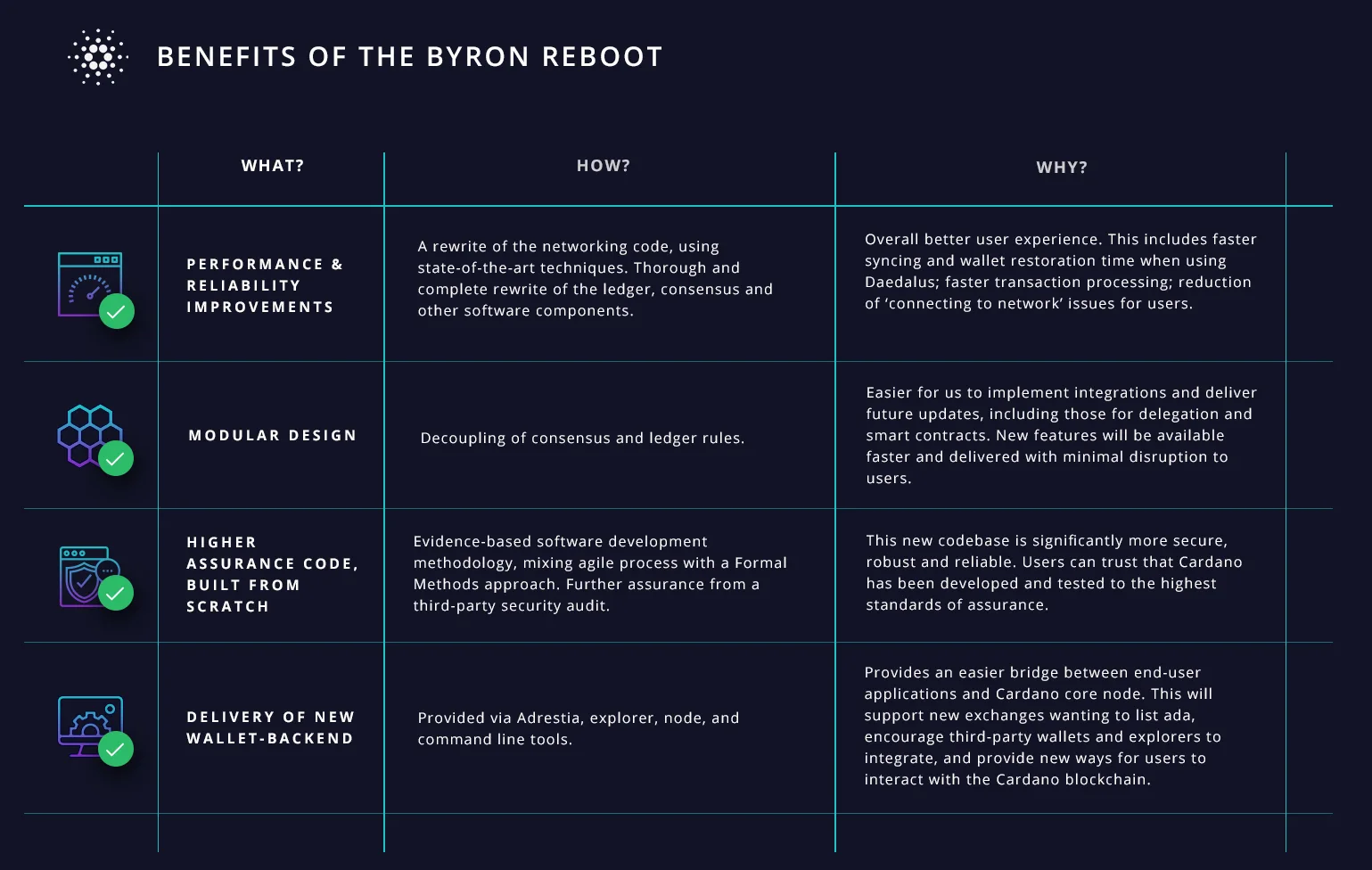
After the implementation of the Shelley, set for a late Q2 2020 release, earned staking rewards will be transferred to the mainnet. The network will also then rely on consensus through PoS rather than nodes controlled by IOHK, Emurgo, and the Cardano Foundation.
Turning to developer activity, the ADA project on GitHub has 269 repos, over 15 of which have been highly active in the past 90 days. Most coins use the developer community of GitHub where files are saved in folders called "repositories," or "repos," and changes to these files are recorded with "commits," which save a record of what changes were made, when, and by who. Although commits represent quantity and not necessarily quality, a higher number of commits can signify higher dev activity and interest.


On the network, the total number of transactions per day (line, chart below) have ranged between 1,000 and 4,000 since April 2018. Transactions per day nearly quadrupled from January to February this year. Average transaction value (fill, chart below) has decreased from US$77,000 in late 2019 to US$12,000 currently. The causes for a spike in average transaction values in March and July 2018 are unclear, but likely related to large holders splitting coins between wallets and not necessarily economic value transfer.

The 30-day Kalichkin network value to estimated on-chain daily transactions (NVT) ratio (line, chart below) has decreased to multi-year lows. Inflection points in NVT can be leading indicators of a reversal in an asset’s value. An NVT held below 30 should signify bullish market conditions. A clear uptrend in NVT suggests a coin is overvalued based on its economic activity and utility, which should be seen as a bearish price indicator, whereas a downtrend in NVT suggests the opposite.
Monthly active addresses (fill, chart below) have increased substantially since the beginning of the year, holding above 6,000. Daily active addresses hit an all-time high of 45,000 in February 2018. Active and unique addresses are important to consider when determining the fundamental value of the network based on Metcalfe's law. The data for total unique addresses could not be obtained.

In the markets, exchange traded volume is led by Tether (USDT), Bitcoin (BTC), and U.S. Dollar (USD) pairs on Binance and Huobi. ADA was listed on Kraken in September 2018 and Binance.US in October 2019. No ADA pairs are currently listed on Bitfinex or Coinbase. In July 2018, Coinbase announced the possibility of adding ADA to the platform, but a listing has yet to materialize.
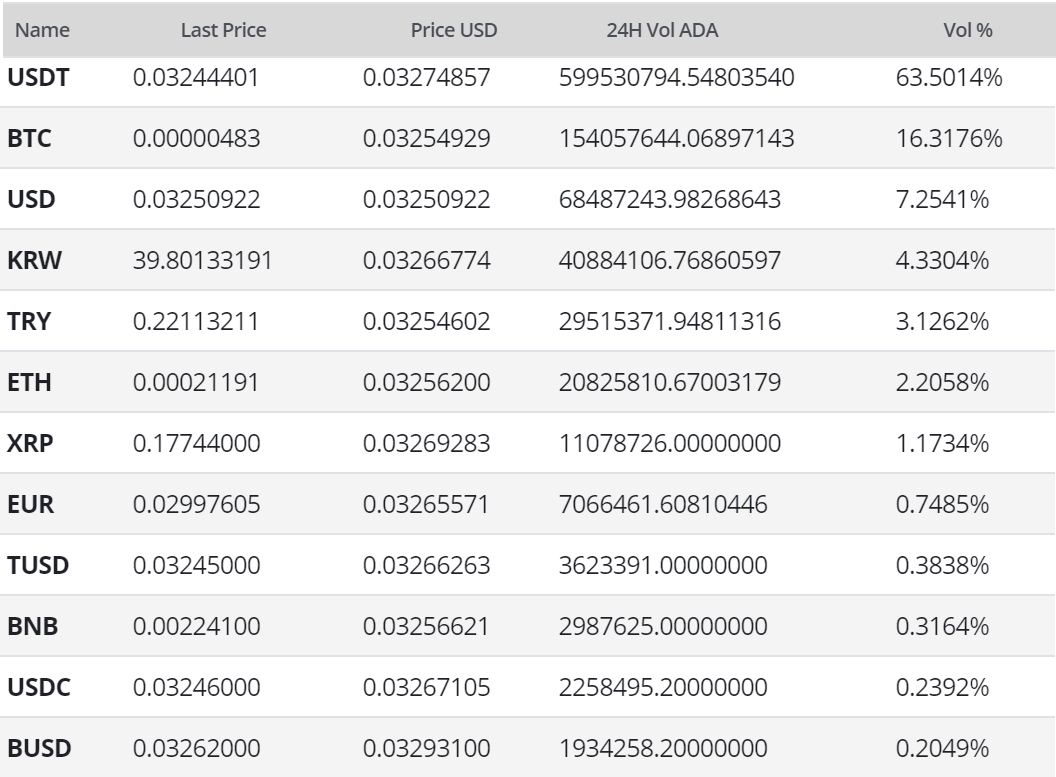
Aside from a brief period in late 2017, Google Trends data for the term "Cardano" has mostly been pinned to the floor. The increase in 2017 likely signaled a large swath of new market participants at that time. A 2015 study found a strong correlation between the Google Trends data and Bitcoin price, while a 2017 study concluded that when the U.S. Google "bitcoin" searches increase dramatically, Bitcoin price drops.

Technical Analysis
Potential roadmaps for upcoming price movements can be found on high timeframes using Exponential Moving Averages, volume profiles, and Ichimoku Cloud. Further background information on the technical analysis discussed below can be found here.
On the ADA/USD daily chart, the 50-day Exponential Moving Averages (EMA) and 200-day EMA bearishly crossed on March 13th, following a 31-day bullish trend. The 200-day EMA, currently at US$0.44 should now act as resistance. Significant volume resistance (horizontal bars, chart below) also sits at the US$0.036 - US$0.047 zone, with no significant volume support below current price. Any further upside will likely find resistance at the US$0.060 and US$0.090 yearly pivots. There are no active bullish or bearish divergences at this time.
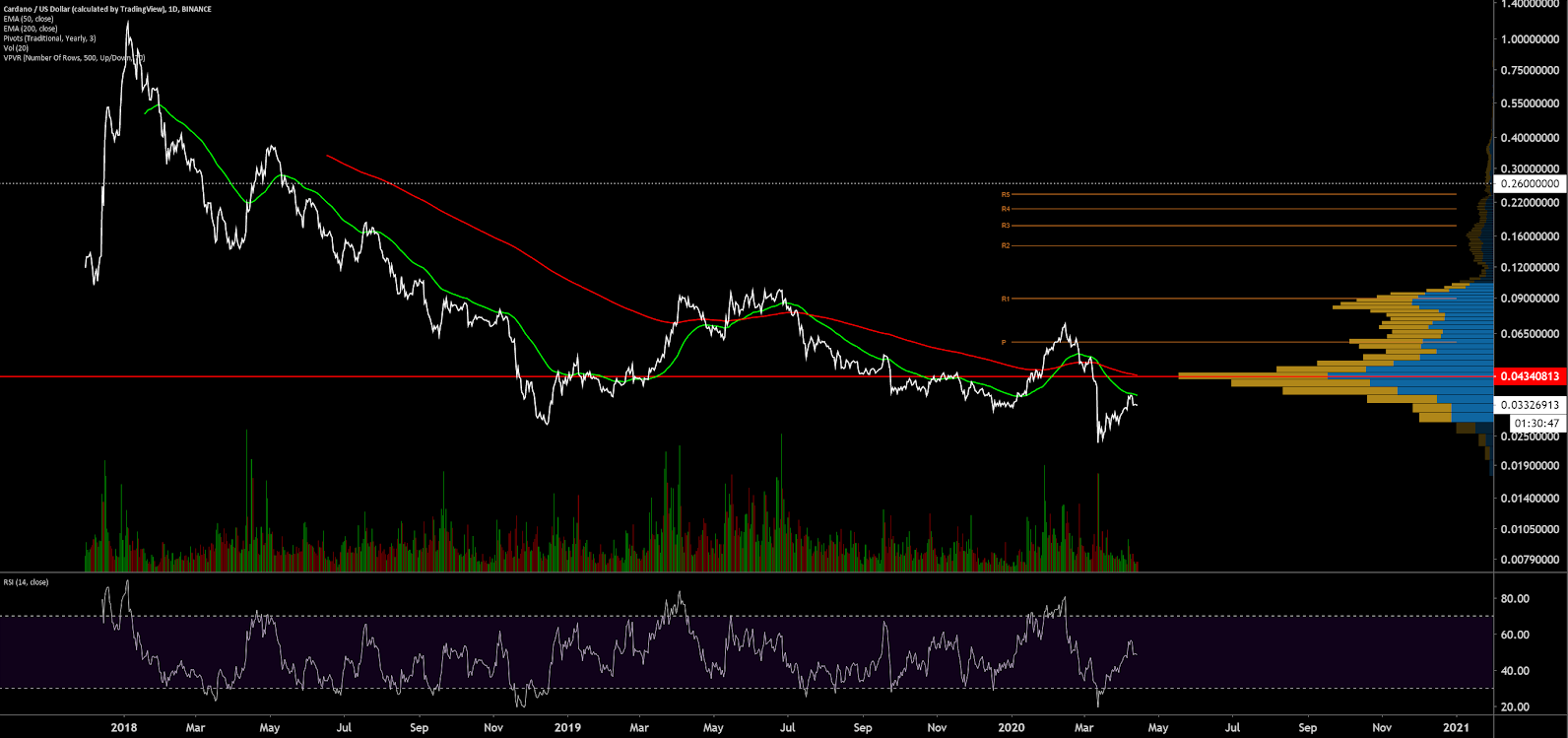
Turning to the Ichimoku Cloud, four metrics are used to indicate if a trend exists; the current price in relation to the Cloud, the color of the Cloud (red for bearish, green for bullish), the Tenkan (T) and Kijun (K) cross, and the Lagging Span. The best entry always occurs when most of the signals flip from bearish to bullish, or vice versa.
The status of the current Cloud metrics on the daily time frame with doubled settings (20/60/120/30), for more accurate signals, are bearish; the spot price is below the Cloud, the Cloud is bearish, the TK cross is bearish, and the Lagging Span is below the Cloud and near the current spot price. The trend will remain bearish so long as the spot price remains below the Cloud. A long flat Kumo at US$0.045 should act as a magnet for the spot price.
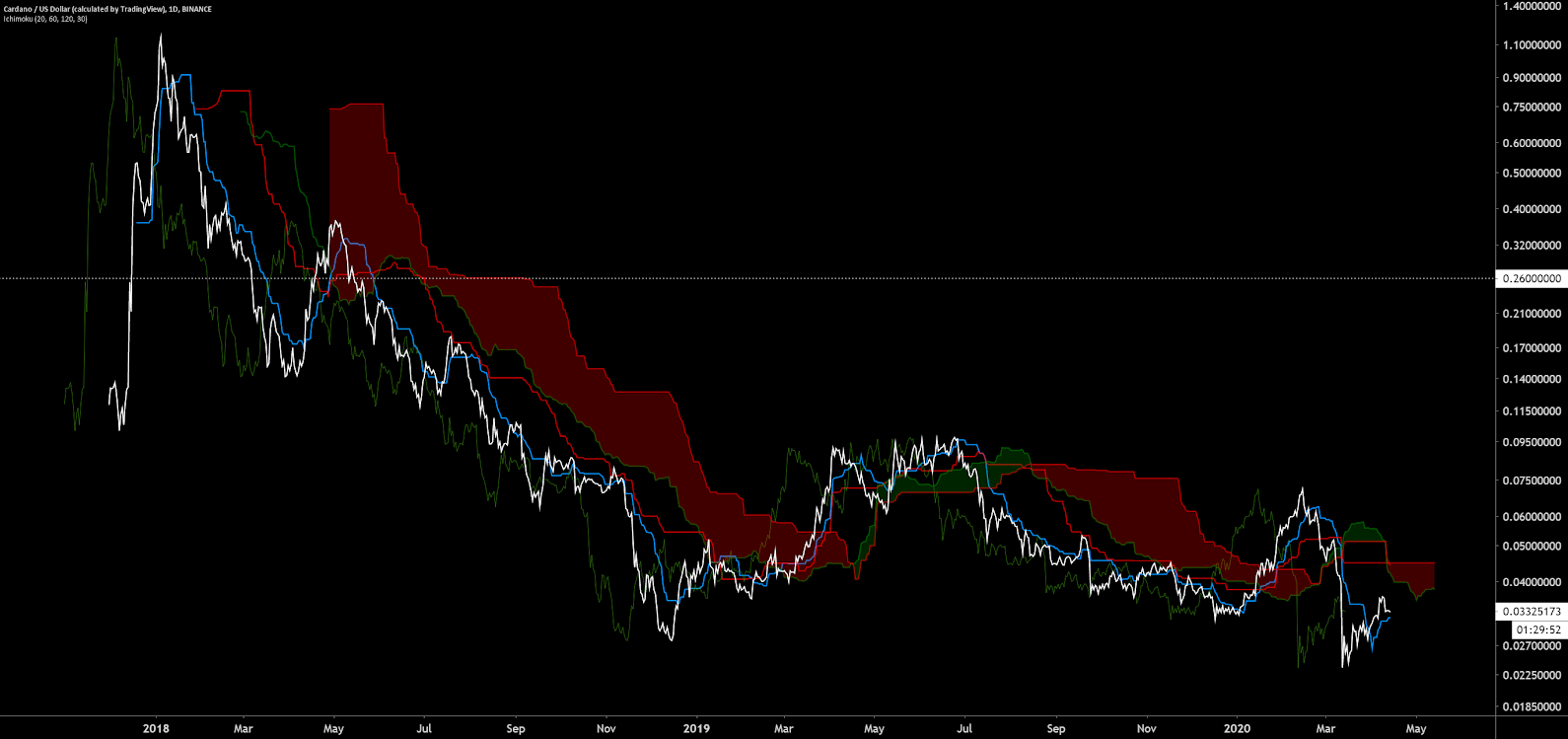
For the ADA/BTC pair, the daily chart also shows bearish trend metrics. Since April 2019, the spot price has largely remained below the 200-day EMA and below the daily Cloud. Before January, the spot price held within a 180-day accumulation zone from 400 to 530 sats, where price has returned over the past few weeks.
Based on trend metrics, a long entry is not warranted until the spot price is once again above the 200-day EMA and daily Cloud at 550 sats. There is relatively little overhead volume resistance until the previous accumulation zone from 950 to 1,300 sats. The 1,000 and 2,000 sat levels will also likely act as psychological resistance.
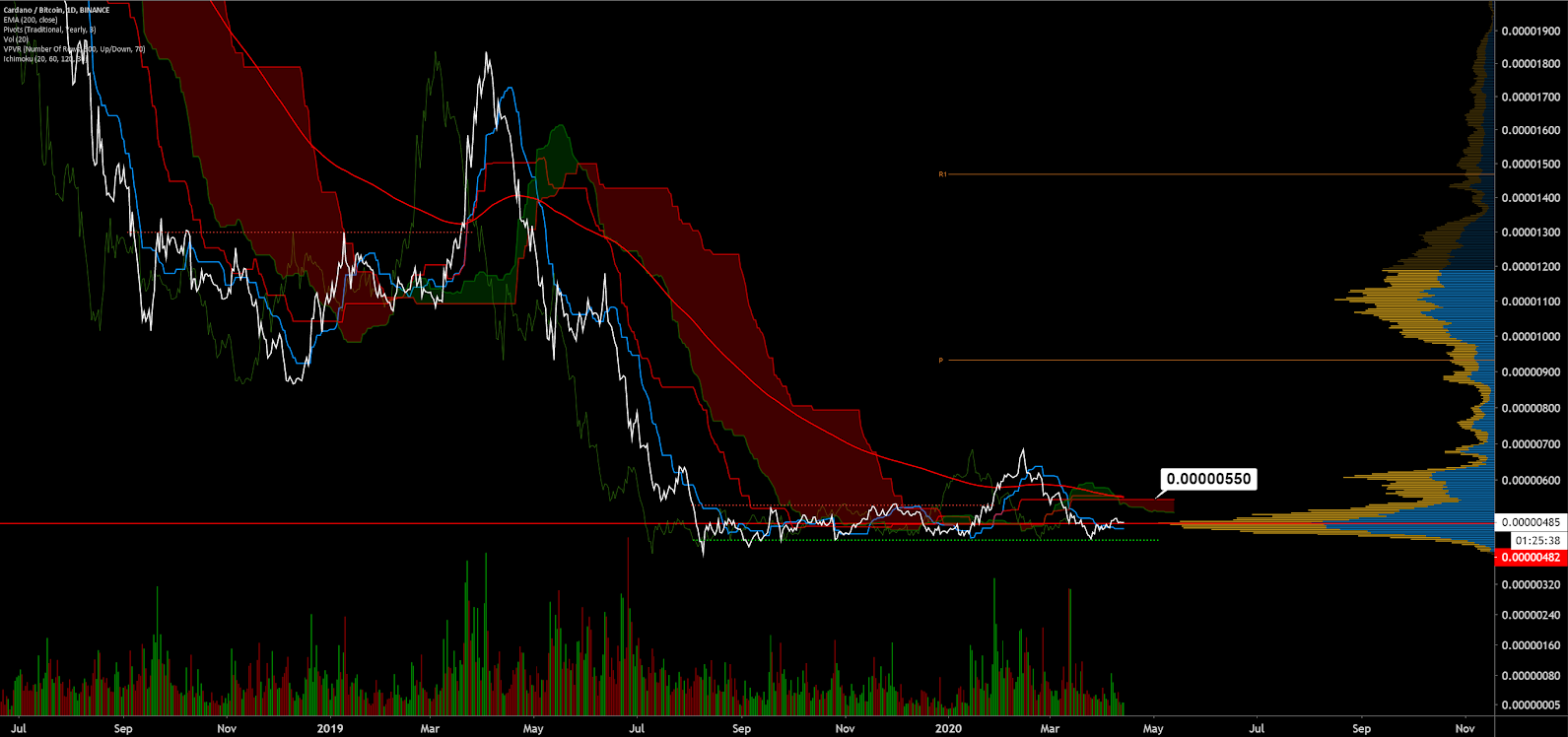
Conclusion
Cardano is currently a centralized testnet platform hoping to release a decentralized mainnet later this year. If a mainnet launch with staking is successful, exchange listings and exchange staking pools will likely follow. Multiple additional phases of future protocol upgrades are also being released concurrently over time, with a very active development team relative to other blockchains. On-chain fundamentals have essentially remained flat over the past two years, which will likely change once a mainnet is released.
Technicals for both ADA/USD and ADA/BTC reveal a bearish trend, as the spot prices are currently below both the 200-day EMA and the daily Cloud. The ADA/USD and ADA/BTC pair will need to close above US$0.045 and 550 sats, respectively, to initiate a bullish trend. Significant upside resistance for ADA/USD, based on volume and yearly pivots sits at US$0.10 should a bullish trend commence. ADA/BTC does not have any significant overhead resistance until 1,000 sats, should the price exceed the 550 to 650 sat zone.
OhNoCrypto
via https://www.ohnocrypto.com
Josh Olszewicz, Khareem Sudlow
